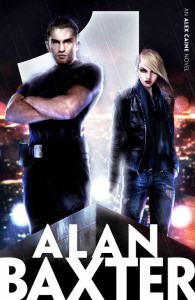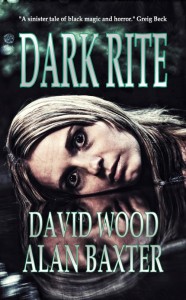DISCLAIMER: Thirteen O’Clock is managed by Alan Baxter, Felicity Dowker and Andrew McKiernan as Contributing Editors. While the Contributing Editors’ roles at Thirteen O’Clock are editorial and critique, all three are primarily writers. It is inevitable that their own work will form part of the Australian and international dark fiction publications which are Thirteen O’Clock’s focus, and as such it is also inevitable that their work will be reviewed at Thirteen O’Clock (to prohibit this would not only be unfortunate for Baxter, Dowker, and McKiernan themselves, but for their hardworking editors and publishers).
Thirteen O’Clock will always have a third party contributor review the Contributing Editors’ work. Such reviews will be unedited (aside from standard corrections to typos and grammar), posted in full (be they negative or positive), and will always be accompanied by full disclosure of Baxter, Dowker, and McKiernan’s place at Thirteen O’Clock. At no point will Baxter, Dowker or McKiernan review their own work.
Bound by Alan Baxter
Harper Voyager 2014
review by Geoff Brown
The first Alex Caine book, Bound, is the inaugural mass market urban fantasy release by Alan Baxter through Harper Voyager, the sci-fi/fantasy imprint of Harper Collins. Urban fantasy describes a work that is set primarily in the real world and contains aspects of fantasy. I received a proof copy of this fantastic book well prior to the release date in June, and read it in three sittings. I thoroughly enjoyed the chance to read this.
Bound tells the story of illegal underground fighter Alex Caine, who has certain abilities that seem magical. Alex can see people’s physical intent prior to their actions, allowing him to react in combat in a way almost impossible. Baxter is a highly-skilled martial artist himself, and writes the fight scenes in ways that are both visceral and realistic. I had no trouble visualising the combat within the book as it was happening, something I always judge in any book that features strong combat scenes. Believable yet exciting fighting is very hard to pull off, and Baxter does it well.
As Bound opens, Caine is approached by a man claiming that magic is real, and that Caine himself is a natural user of magic. What starts as a casual and unwanted job reading a magic text turns into an epic journey of discovery and conflict for Caine. Written as a classic Hero’s Journey, Caine at first refuses the call, yet finds himself unable to avoid the tests thrown at him by the antagonist. The revelation of the mysteries that flow throughout Bound are timed perfectly to maintain and escalate the reader’s interest, keeping up a pace that encourages rather than bores or overstimulates. The plot moves along nicely, and ticks all the boxes. The character development is great, and the overall charm of Bound shines through without being lost in the writing itself.
The first part of the book follows Alex as he is introduced to the real magic inherent in the world around him, and then the antagonist is introduced and the real action kicks in. That’s not to say the first part is without action; that’s simply not the case. But after the main foe makes his appearance, the action level kicks up even more than up to that point. Fantastic creatures appear, all hellbent on taking out Alex, and it is up to him and his, at times unwanted, mentor and companion to survive and follow the clues to the climax. By the end, all the subplots are wound up nicely, but I did think the ending came on a little fast once it hit. There is certainly room in the ending and the mythos for further Alex Caine adventures, and the clue that these are forthcoming is the text ‘Alex Cain #1’ that is blindingly obvious on the cover of the Advance Review Copy I was gifted by the publisher. To tell you the truth, I can’t wait to see where this exciting and compelling new series will go from here.
***
 Geoff Brown is an Australian writer raised in Melbourne’s gritty Western Suburbs. He writes as GN Braun. He is a trained nurse, and holds a Cert. IV in Professional Writing and Editing, as well as a Dip. Arts (Professional Writing and Editing). He writes fiction across various genres, and is the author of many published short stories. He has had numerous articles published in newspapers, both regional and metropolitan. He is the past president of the Australian Horror Writers Association and past director of the Australian Shadows Awards. He is an editor and columnist for UK site This is Horror, and the guest editor for Midnight Echo #9. His memoir, Hammered, was released in early 2012 by Legumeman Books. He is the owner of Cohesion Editing and Proofreading, and has now opened a publishing house, Cohesion Press.
Geoff Brown is an Australian writer raised in Melbourne’s gritty Western Suburbs. He writes as GN Braun. He is a trained nurse, and holds a Cert. IV in Professional Writing and Editing, as well as a Dip. Arts (Professional Writing and Editing). He writes fiction across various genres, and is the author of many published short stories. He has had numerous articles published in newspapers, both regional and metropolitan. He is the past president of the Australian Horror Writers Association and past director of the Australian Shadows Awards. He is an editor and columnist for UK site This is Horror, and the guest editor for Midnight Echo #9. His memoir, Hammered, was released in early 2012 by Legumeman Books. He is the owner of Cohesion Editing and Proofreading, and has now opened a publishing house, Cohesion Press.
.


 The Darkest Shade of Grey
The Darkest Shade of Grey